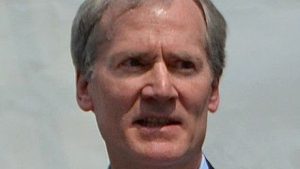Marc Tessier-Lavigne, the former president of Stanford University who resigned following scrutiny of his published papers and an institutional research misconduct investigation, has retracted a third paper, this one from Cell.
Last week, Tessier-Lavigne retracted two articles from Science that had been published in 2001.
The Cell paper, A Ligand-Gated Association between Cytoplasmic Domains of UNC5 and DCC Family Receptors Converts Netrin-Induced Growth Cone Attraction to Repulsion, was published in 1999. It has been cited 577 times, according to Clarivate’s Web of Science.
The retraction notice was posted Monday. It states:
This article has been retracted at the request of the authors.
In 2015, we, the authors, consulted with Cell editors about issues that had been brought to our attention about this paper, specifically image splicing in Figures 3C, 5A, 5B, and 7B–7D and duplication of blank blots in Figure 7C. Cell declined to publish a Correction at that time because in 1999, when the paper was published, the journal did not have policies prohibiting unmarked image splicing and because, for the duplication, there was insufficient information to determine intent, and the impact of the duplication on the paper’s conclusions was limited. In 2022, when new concerns were raised, Cell posted an Editorial Expression of Concern (Cell 186, 230 [2023], https://doi.org/10.1016/j.cell.2022.12.019) while an institutional investigation was conducted. The investigation is complete and has revealed further issues including manipulation of data-containing portions of Western blot images in Figures 3A–3C, 7A, 7B, and 7D, undermining confidence in the paper’s conclusions (https://boardoftrustees.stanford.edu/wp-content/uploads/sites/5/2023/07/Scientific-Panel-Final-Report.pdf). As a result, we are retracting the paper. We regret the impact of these issues on the scientific community.
Two of the authors, K. Hong and M. Nishiyama, could not be contacted to sign this retraction. E. Stein declined to sign the retraction.
Tessier-Lavigne did not immediately respond to our request for comment.
The “issues” the authors discussed with the Cell editors in 2015 were flagged by anonymous PubPeer users, as also happened with the Science papers retracted last week.
Stanford’s investigation of the allegations, spurred by reporting in the student newspaper, determined four of Tessier-Lavigne’s papers contained “apparent manipulation of research data by others,” but Tessier-Lavigne was not responsible.
In a statement posted to his lab website on July 19, the same day as Stanford’s report was published, Tessier-Lavigne wrote that he planned to retract the Science and Cell articles and was in touch with Nature about a “thorough correction” to a 2004 paper.
Like Retraction Watch? You can make a tax-deductible contribution to support our work, follow us on Twitter, like us on Facebook, add us to your RSS reader, or subscribe to our daily digest. If you find a retraction that’s not in our database, you can let us know here. For comments or feedback, email us at [email protected].

I am curious, anyone know whether the paper correct in its conclusions? have they been supported by subsequent studies? Seems likely, given the many citations of the paper.
“four of Tessier-Lavigne’s papers contained “apparent manipulation of research data by others,” but Tessier-Lavigne was not responsible. ”
Surprised that the corresponding author is not responsible for apparent data manipulation.
So this is interesting and I think a consequence of how the summary was written. Clearly the PI has overall responsibility for whatever research is described in publications and any fallout in the event that there are issues – but I think there are two levels of responsibility for misconduct. First if the PI actually commits the misconduct – i.e., falsify the data in any way, plagiarize or any of the things that are reported on this site – clearly the PI is directly responsible and should suffer appropriate consequences. The second is when a co-worker (whether that is a colleague or a trainee) commits the misconduct – I think it is totally possible for the PI not to be aware of this even if their co-workers are sharing all their data all the time. I read the finding in this light – that Tessier-Lavigne did not commit the misconduct personally and so has “indirect” responsibility. Now of course, one can argue that if he had his finger on the pulse of his group he might have noticed it, but you have to trust the people you work with to do the right thing. That starts with establishing the right environment, but that is probably another discussion. It also means that if problems are discovered (by whatever means) that they are handled appropriately by correcting the record (retraction or correction) as expediently as possible.
Interestingly, nobody took a notice that in all these papers from 1997 till 2003 method of purification of the Netrin-1 (main acting protein) is omitted.